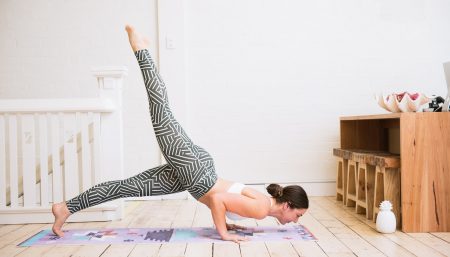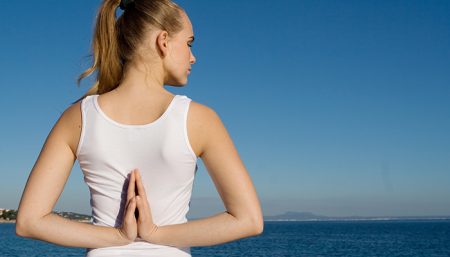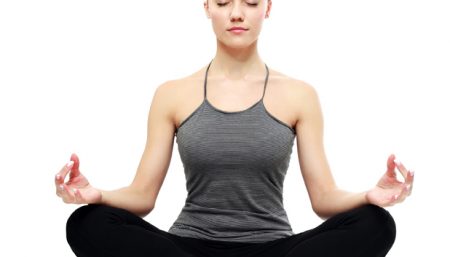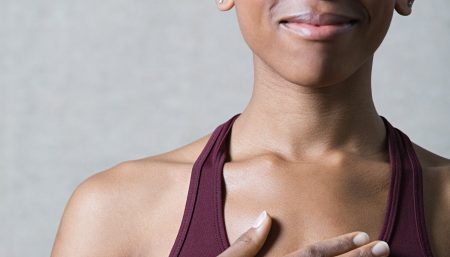Balancing your chakras can be carried out by many simple yoga poses, inorder to bring more harmony to your energetic body. These vital energy centers are sensitive to energy and often become clogged with residues from physical, emotional, mental, and spiritual disturbances and traumas.
1. Tree Pose (Vrksasana) / Root Chakra (Muladhara)

Great for feeling more alert, secure, and stable. The Muladhara governs your family ties and feelings of survival, belonging, and guardedness.
- Stand on your left leg and bend your right knee, turning it out to the side. Rest your right heel against your left leg with your right toes on the floor. You can either place the foot of the right leg on the left ankle with the toes on the ground, or move it higher up above the knee, the classical version of this pose. However, you should never place your foot on your opposite knee. Once you’ve found a comfortable position for your foot, bring your hands together at your heart center.
- Lift the arms and the gaze overhead. Your abdomen should be relaxed and your standing leg should remain straight.
- Find a steady point for your gaze and breathe deeply. Stay for a comfortable length of time then gently release and then move into tree on the other side.
2. Virabhadra (Warrior Pose) / Root Chakra (Muladhara)
This challenging pose strengthens the entire body while improving mental capacity and self control.
- Stand in mountain pose continuing with your smooth flowing breath. Jump your feet sides ways and sweep your arms out to the side so your ankles are below your wrists. Establish your foundation, by pulling your knees and thighs up, tucking your tailbone under, pushing your feet firmly into the floor. Visualize an imaginary line running vertically down the centre of your body, dropping your shoulders. Squeeze your arms and legs away from the centerline. Keep an awareness of this line as you turn your right foot out to 90 degrees and turn your left foot in to 70 degrees.
- Ensure the heel of your front foot aligns with arch of your back foot, hips facing forward. If your body wants to turn off centre, counter-act it by pushing simultaneously in opposite directions from the centre line.
Inhale, an as you exhale bend your right leg, pulling up with the outside and inside of the thigh to form a right angle at the knee. Only go as low as you can with out turning your hips off centre. Ideally you want your knee directly above your ankle with you leg coming vertically out of the floor like pillar. Keep the power flowing through the back leg into the floor. Inhale lift the spine; exhale turn your head to look over your right arm. - Take a few deep breaths through the nose. Hold the pose and breathe smooth. Reverse the procedure back to mountain pose and repeat back to the other side.
- Hold each Lunge or Warrior pose with the dominant leg back, stretching the hip flexors for about 6 slow, steady breaths. (This should be equivalent to at least 30 seconds). When the dominant leg is forward, hold for about 3 breaths (at least 15 seconds).
3. Goddess Pose (Deviasana) / Sacral Chakra (Svadhisthana)
This chakra corresponds with your reproductive and sexual organs, and represents fluidity, creativity, and fertility.
- Step your feet wider than hip-width apart (approximately 2—3 feet) and lift the arms out to the sides at shoulder height.
- Turn your feet out 45 degrees and bend the knees to a comfortable stance, making sure that your knees track directly over the ankles.
- Turn your palms up and bend the elbows to 90 degrees so that your palms face in toward your head.
- Inhale through your nose, drawing in abundant energy, healing, and relaxation, as you reach both arms overhead.
- Exhale through your mouth, bend your elbows, and pull your fists down alongside the ribs, emphatically saying, “Ha!” Repeat 10–15 times while holding the pose.
4. Boat Pose (Naukasana ) / Navel Chakra (Manipura)
By working on this chakra, you can awaken your true personal inner power and work through your fear of taking risks.
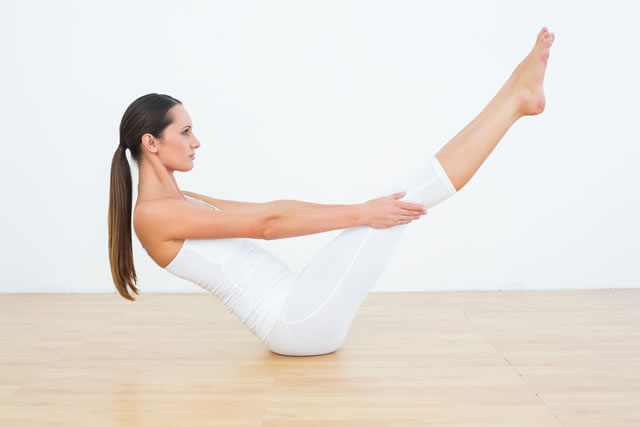
- Lie down straight on the abdomen with forehead resting on the floor.
- Keep your feet together and arms extended forward with palms on the floor. While inhaling, raise your arms, head, neck, shoulders, trunk and legs simultaneously as high as possible.
Keep your elbows and knees straight. Balance the entire weight of your body on the navel. Maintain this posture as long as possible. - While exhaling, bring down your legs, hands and forehead to the ground. Then relax in Makarasana.
5. Bow Pose (Dhanurasana) / Navel Chakra (Manipura)
By working on this chakra, you can awaken your true personal inner power.
- Take prone lying position, legs together, hands straight by the side of the thighs, chin resting on the ground.
- Fold the legs at the knees and bring them on the thighs. Knees must remain together.
- Bring your hands backward and hold the toes of respective legs from the thumb and forefinger of the respective hands.
- Raise your legs a little up and simultaneously raise your head and chest.
- Holding the toes, pull the legs towards ears and bring the toes near the ear. Gaze in front.
- While returning to this original position, loosen your hands, take legs backward, let the thighs touch the ground, leave the toes and ultimately bring the legs and hand to the first position.
6. Camel Pose (Ustrasana) /Heart Chakra (Anahata)
Awaken to the power of unconditional love within you through compassion, forgiveness, and acceptance.
- Press the top of your feet to the floor and avoid your feet cycling inward
- Set your feet and shins parallel to each other. If your knees slide out you will jam your sacrum
- Slide the buttock muscles down away from your low back. This can be done manually as you go back into the pose
- When entering, it is initially important to go upward. Imagine that you are like a high-jumper going over a bar. Don’t hit the bar with your trunk by going straight back.Press your thighs forward, away from your feet.
- Externally rotate your arms and draw your collarbones away from one another.Lift your sternum and side chest as much as possible, creating the characteristic dome shape of the chest. Release slowly and relax.
7. Supported Shoulderstand (Salamba Sarvangasana) / Throat Chakra (Vishuddha)
When this chakra is open and stimulated, your voice moves through space to help you communicate your emotions in healthy ways. This asana helps promote good circulation, as it directs the flow of the entire lower body towards the heart.
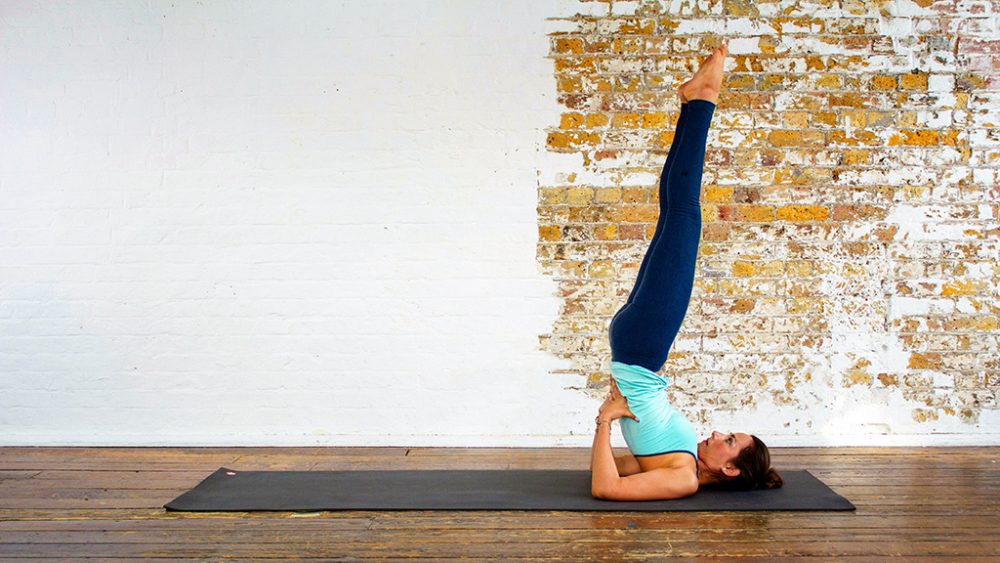
- Lie down flat on the floor, on your back, palms by your side facing. Exhale and lift your legs up 30, then 60, then 90 and then around 130 degrees so they are extended behind your head.
Stay in this position, breathing normally, for a few seconds. - Now, gradually, exhale again, and straighten your legs up to 90 degrees, lifting your buttocks as well. Support the back of your trunk with your palms, keeping elbows on the floor. Gradually, walk your hands towards your shoulder blades, as you lift your body higher. Your elbows may tend to move outwards. Bring them in, so they are straight in line with your shoulders. You will notice that your hips tend to jut out backwards, while your feet tend to come forward over the head. This is not the right way to do it. Work at it so your body is in a straight line. Your hips, feet and shoulders should be aligned, so push your feet back and bring your hips and tailbone forward. Remember, this exercise is not as much about effort as it is about balance.
- Lift your body as high up as possible. Sarvangasana is a shoulder stand, so your body should be resting on your shoulders and not on your back.
- Hold this position for as long as possible.
- Remember to exhale while lifting your body up, but once your body is up, you can breathe normally. There is no need to hold your breath.
- Time yourself, so you can see how long you can remain in this position. The next time, try and balance your body for a little longer.
8. Supported Bridge Pose (Salamba Setu Bandha Sarvangasana) / Throat Chakra (Vishuddha)
When this chakra is blocked, you may feel like you can’t find your voice or your truth.
- Come to lie on your back with the knees bent and the soles of your feet flat on the floor. Have a yoga block handy.
- You should be able to barely touch the backs of your heels with your fingertips when the arms are lying on the floor. The feet should be parallel and stay that way through the duration of the pose.
- Press down into the soles of the feet as you lift the hips off the floor.
- Slide your yoga block under your back directly under the sacrum. Let your sacrum rest on the block. Let the arms rest alongside the body.
- This should be a comfortable resting position. You may wish to stay here several minutes.
- To come out, press down into your feet and lift the hips again. Remove the block and gently lower your back to the floor.
9. Easy Pose (Sukhasana) / Third-Eye Chakra (Anja)
This chakra is associated with your intuition, or sixth sense, and governs how the rest of the chakras function.
- Sit on the floor with legs stretched out. Always use a yoga mat or a cushion or a carpet while sitting on the floor.
- Fold the left leg and tug it inside the right thigh.
- Then fold the right leg and tug in inside the left thigh.
- Keep the hands on the knees. Jnana mudra or Chin mudra can be used if you are using this posture for meditation.
- Sit erect with spine straight.
- Relax your whole body and breathe normally.
Maintain this position for as long a comfortable.
10. Corpse Pose (Savasana) / Crown Chakra (Sahasrara)
The crown chakra connects to beauty itself and the spiritual realm.

- Spread the mat on the floor. Place a bolster on the mat, with its long sides parallel to the long sides of the mat. Sit in Dandasana (Staff pose) with the short end of the bolster against your buttocks, and place the folded blanket on the far end. If you have osteoarthritis of the knees or if your legs are feeling tired, place a bolster under your knees.
- Wrap the bandage around your forehead, following the instructions for Ujjayi Pranayama. Now place your elbows and forearms on the mat. Lower your back, vertebra by vertebra, onto the bolster until your head rests comfortably on the folded blanket. Position your buttocks evenly on the centre of the mat. Spread out your arms to the sides, palms facing up, and rest them on the floor.
- Straighten your legs and stretch them evenly away from each other, without disturbing the extension of your waist. Exhale, focusing on your breathing, then lift and stretch your diaphragm, keeping it free of tension. Keep your arms at a comfortable distance from your body. If they are placed too near or too far away, your shoulders will lift off the bolster.
- Stretch your shoulders away from your neck. The centre of your back should be on the centre of the bolster, keep your abdomen soft and relaxed. Expand your chest and relax your throat. Until you feel a soothing sensation in the neck. Ensure that your head does not tilt back. Relax your facial muscles and your jaw. Do not clench your teeth.
- Keep your breathing smooth and free of tension, but do not breathe deeply. Let your eyeballs relax into their sockets, and allow external surroundings to recede. Feel the energy flow from your brain to your body body as the physical, physiological, mental, intellectual, and spiritual lanes come together. Stay in the pose for 5 – 10 minutes.
Chakra balancing is the perfect way to make sure your bodies energy system is running optimally!
Disclaimer
The Content is not intended to be a substitute for professional medical advice, diagnosis, or treatment. Always seek the advice of your physician or other qualified health provider with any questions you may have regarding a medical condition.
